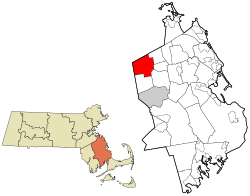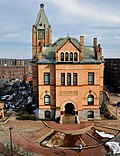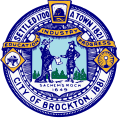Brockton, Massachusetts | |
|---|---|
| Nickname: The City of Champions | |
| Motto: "Education, Industry, Progress" | |
 Location in Plymouth County in Massachusetts | |
| Coordinates: 42°05′00″N71°01′08″W / 42.08333°N 71.01889°W | |
| Country | |
| State | |
| County | Plymouth |
| Settled | 1700 |
| Incorporated (town) | 1821 |
| Incorporated (city) | 1881 |
| Government | |
| • Type | Strong mayor/council |
| • Mayor | Robert F. Sullivan |
| Area | |
• Total | 21.52 sq mi (55.73 km2) |
| • Land | 21.33 sq mi (55.25 km2) |
| • Water | 0.19 sq mi (0.48 km2) |
| Elevation | 112 ft (34 m) |
| Population (2020) | |
• Total | 105,643 |
| • Density | 4,952.2/sq mi (1,912.05/km2) |
| Time zone | UTC−5 (Eastern) |
| • Summer (DST) | UTC−4 (Eastern) |
| ZIP Codes | 02301–02305 |
| Area code | 508/774 |
| FIPS code | 25-09000 |
| GNIS feature ID | 0617571 |
| Website | www |
Brockton is a city in Plymouth County, Massachusetts, United States; the population was 105,643 at the 2020 United States census. Along with Plymouth, it is one of the two county seats of Plymouth County. [2] It is the sixth-largest city in Massachusetts and is sometimes referred to as the "City of Champions", due to the success of native boxers Rocky Marciano and Marvin Hagler, as well as its successful Brockton High School sports programs. Two villages within it are Montello and Campello, both of which have MBTA Commuter Rail Stations and post offices. Campello is the smallest neighborhood, but also the most populous. Brockton hosts a baseball team, the Brockton Rox of the Frontier League. It is the second-windiest city in the United States, with an average wind speed of 14.3 mph (23.0 km/h). [3]
Contents
- History
- Historical firsts
- Geography
- Climate
- Demographics
- 2020 census
- Income
- Arts and culture
- Music
- Festivals
- Library
- Notable sites
- Sports
- Government
- Education
- Public schools
- Private schools
- Higher education
- Infrastructure
- Transportation
- Healthcare
- Fire department
- Law enforcement
- Notable people
- Awards
- References
- External links

















